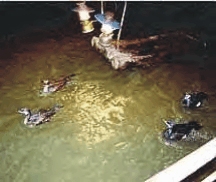
Summer Research Program for Secondary School Teachers
William H. Maxwell Career and Technical High School
August 2003
What does the aim of a cormorant tell us about the behavior of light?
Objectives: The student will be able to:
1. Use the scientific method to determine the aim of a cormorant when diving for fish
2. Work cooperatively to investigate the behavior of light in different mediums.
3. Extend this investigation to define refraction.
Prior Knowledge:
1) The scientific method.
2) experience with working in cooperative groups.
Materials:
Each group receives:
a coin ( quarters work well)
an opaque cup
a cup of water
a cup of oil
a cup of alcohol

Fishing Cormorants in Guilin, China
Motivation:
1)Form Cooperative groups, preferably, of four.
2)Begin the discussion by saying:
Cormorants are birds used by fisherman of the Orient. They are large voracious dark-colored long-necked sea birds with a pouch for holding fish. With their long sharp bills they dive into the water to pierce fish and take the fish back to the fisherman.
3)Then ask the following: where will a cormorant aim in order to pierce the fish, above it, below it, or directly toward it? State a hypothesis to answer the question.
(Teaching Standard E: The activity provides the structure for collaboration between students.)
4)Say the following: today you will perform an investigation that will help you to determine the aim of the cormorant bird.
(Teaching Standard D – Students are provided with resources, space and time to engage in inquiry-based tasks.)
Procedure:
A) Assign roles: viewer, the recorder, the reader, reporter
(Teaching Standard B: Teachers of science guide and facilitate learning. In doing this, teachers challenge students to accept and share responsibility for their own learning.)
B) Within the cooperative groups the students will:
1)Place an opaque cup in front of the group’s viewer, the person should be able to see down the cup but at an angle.
2) Place a coin into the opaque cup and place it until it is out of view.
3) Pour water into the cup until it becomes completely visible.
4) Record the height of the water in centimeters.
5) Repeat the procedure for oil and alcohol. Record the height of each on the data table.
Let us interpret the results.
Check Questions:
(Teaching Standard B: Learning is facilitated through student/teacher interactions.)
Ask the students the following:
1) Describe what has happened?
The students should be able to state that:
A) when water, oil, or alcohol is poured into the cup the coin becomes visible.
B) also that it requires more water than oil to see the coin.
2) Let’s go a little further, what allows you to see the coin.
Some may say their eyes.
Inform the student that light allows them to see any object and that light bends when it travels into different media. This is called refraction.
(CONTENT STANDARD B: As a result of their activities in grades 9-12, all students should develop an understanding of light energy and matter.)
3) Why is it that we did not see the coin until the water, oil, or alcohol were added?
Light bends when traveling from air to water, air to oil, or air to alcohol. And so the light bends toward the coin as the liquid is poured into the opaque glass allowing one to see it.
4) Based on the experiment, where would a cormorant aim?
Have the students answer, [ Below it.]
5) Does this prove or disprove your hypothesis?
6) Restate your hypothesis if necessary.
(Content Standards: 9-12
Standard A, Science as Inquiry – Students recognize and analyze alternative explanations and models.)
Review
*To determine if the students learned have them right the answer to the following question.
How did you use the scientific method to investigate the aim of the cormorant?
(Science as Inquiry Content Standard A: As a result of activities in grades 9-12, all students should develop abilities necessary to do scientific inquiry and understandings about scientific inquiry)
Data Sheet
|
Height (cm) |
Bending of Light little/ med./high |
|
|
|
Water |
|
|
|
|
|
Oil |
|
|
|
|
|
Alcohol |
|
|
|
|
|
|
|
|
|
|
|
|
|
|
|
|
|
|
|
|
|
|
|
|
|
|
|
|
|
|
|
|
|
|
|
|
|
|
|
|
|
|
|
|
|
|
|
|
|
|
|
|
|
|
|
|
|
|
|